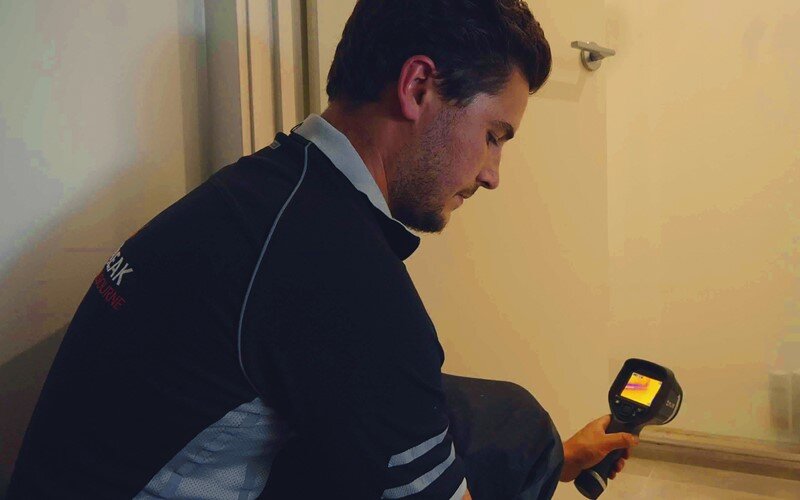Just how to Find as well as Fixing Water Leaks-- A Comprehensive Overview
Call TodayWe have unearthed this post involving Hacks to detect leaks directly below on the net and think it made sense to write about it with you here.

Early detection of dripping water lines can reduce a potential disaster. Some tiny water leaks might not be visible.
1. Examine the Water Meter
Every residence has a water meter. Checking it is a proven way that aids you discover leaks. For beginners, switch off all the water sources. Make certain nobody will flush, utilize the tap, shower, run the cleaning device or dishwashing machine. From there, most likely to the meter and watch if it will transform. Since no person is using it, there should be no motions. If it moves, that indicates a fast-moving leak. If you find no modifications, wait a hr or 2 and check back once more. This implies you might have a slow-moving leak that might even be below ground.
2. Check Water Consumption
Assess your water bills as well as track your water usage. As the one paying it, you need to notice if there are any inconsistencies. If you find sudden changes, in spite of your intake being the same, it means that you have leakages in your plumbing system. Keep in mind, your water costs need to drop under the same range on a monthly basis. An abrupt spike in your expense indicates a fast-moving leak.
A steady increase every month, also with the very same practices, shows you have a slow-moving leak that's also gradually intensifying. Call a plumber to completely inspect your residential property, specifically if you really feel a cozy location on your flooring with piping beneath.
3. Do a Food Coloring Examination
When it comes to water usage, 30% comes from commodes. If the color in some way infiltrates your dish throughout that time without flushing, there's a leak between the container as well as dish.
4. Asses Outside Lines
Do not neglect to inspect your outdoor water lines as well. Must water permeate out of the link, you have a loosened rubber gasket. One tiny leakage can lose tons of water as well as surge your water expense.
5. Evaluate and also Analyze the Situation
Homeowners ought to make it a habit to check under the sink counters and even inside cabinets for any bad odor or mold growth. These two warnings show a leak so timely interest is needed. Doing routine examinations, also bi-annually, can conserve you from a major problem.
More importantly, if you know your residence is currently old, maintain a watchful eye on your heating units, pipes, pipes and so on. Look for stainings and also deteriorating as most pipelines and also home appliances have a life span. They will additionally normally degrade due to tear and also use. If you think leaking water lines in your plumbing system, don't wait on it to intensify. Call a specialist plumber immediately so you do not end up with a terrible mess in your house.
Early discovery of leaking water lines can alleviate a potential disaster. Some little water leaks may not be noticeable. Checking it is a proven way that aids you discover leakages. One little leak can throw away heaps of water and increase your water bill.
If you presume dripping water lines in your plumbing system, don't wait for it to rise.
WARNING SIGNS OF WATER LEAKAGE BEHIND THE WALL
PERSISTENT MUSTY ODORS
As water slowly drips from a leaky pipe inside the wall, flooring and sheetrock stay damp and develop an odor similar to wet cardboard. It generates a musty smell that can help you find hidden leaks.
MOLD IN UNUSUAL AREAS
Mold usually grows in wet areas like kitchens, baths and laundry rooms. If you spot the stuff on walls or baseboards in other rooms of the house, it’s a good indicator of undetected water leaks.
STAINS THAT GROW
When mold thrives around a leaky pipe, it sometimes takes hold on the inside surface of the affected wall. A growing stain on otherwise clean sheetrock is often your sign of a hidden plumbing problem.
PEELING OR BUBBLING WALLPAPER / PAINT
This clue is easy to miss in rooms that don’t get much use. When you see wallpaper separating along seams or paint bubbling or flaking off the wall, blame sheetrock that stays wet because of an undetected leak.
BUCKLED CEILINGS AND STAINED FLOORS
If ceilings or floors in bathrooms, kitchens or laundry areas develop structural problems, don’t rule out constant damp inside the walls. Wet sheetrock can affect adjacent framing, flooring and ceilings.
https://www.servicemasterbyzaba.com/blog/how-to-detect-water-leakage-in-walls/

Do you like reading up on Finding hidden leaks? Create feedback further down. We would be interested to listen to your thoughts about this content. Hoping to see you back again soon. Are you aware of another individual who is sincerely interested in the niche? Please feel free to share it. I enjoy reading our article about Leaking water lines.